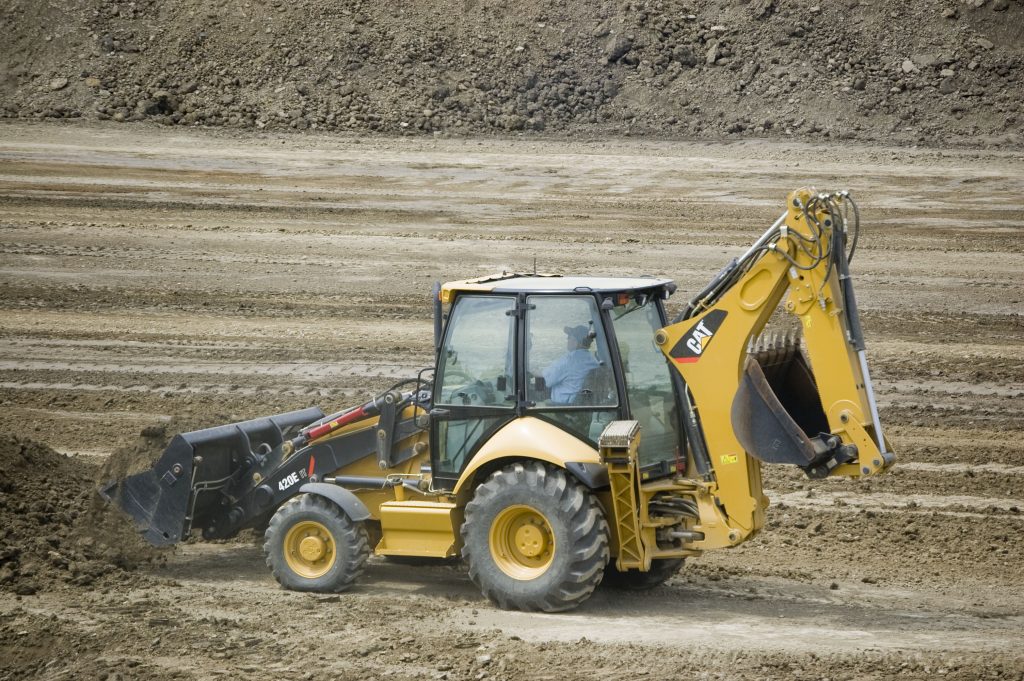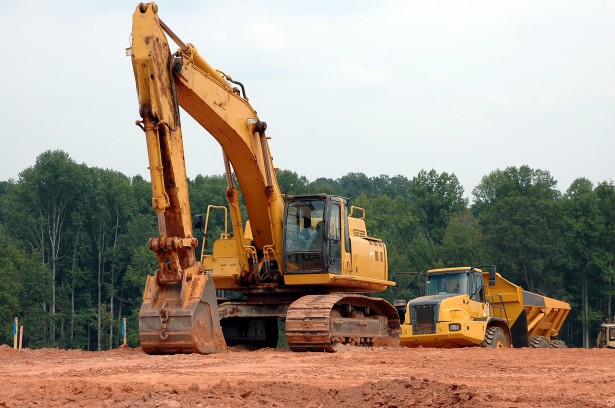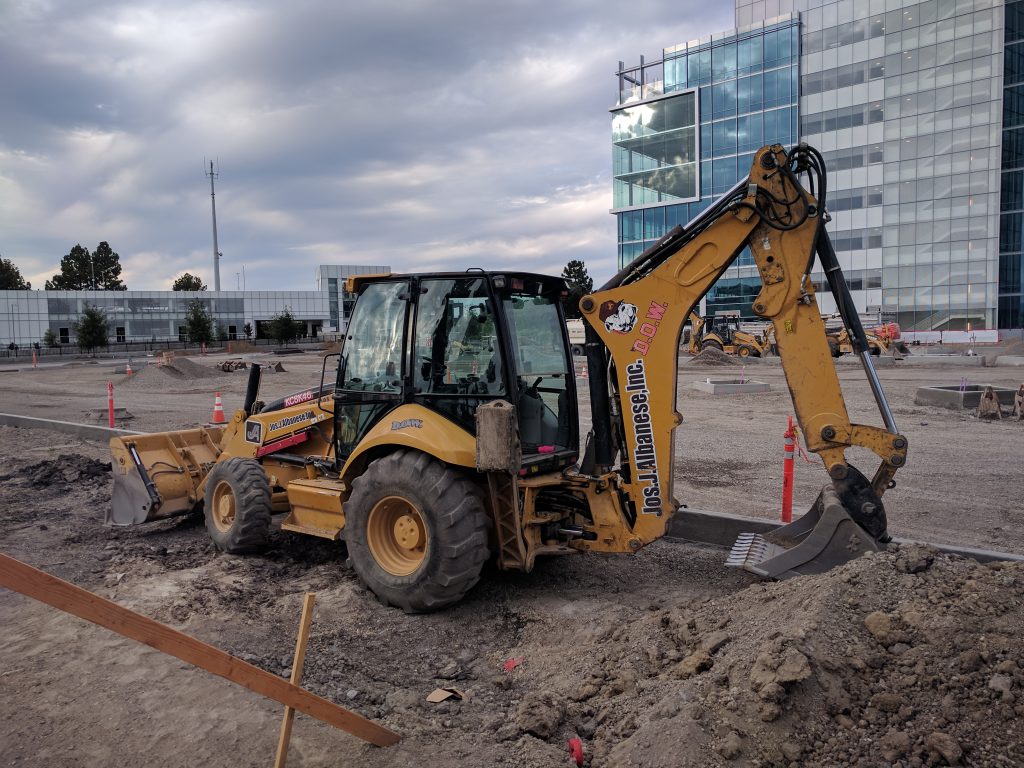The excavator, also known as an excavator or hydraulic excavator, is a piece of construction equipment specialised in earthmoving that enjoys a good reputation in public works thanks to its robustness and versatility. It is mainly used for earthmoving work but can also be used for demolition, clearing and sanitation work. Like mini excavators, excavators consist of an articulated arm with a bucket (or other attachment) for digging, a rotating turret with the engine, a cab and wheels or tracks.
The excavator is an earthmoving machine and can be combined with other extraction machines such as the loader to collect and move the extracted material.
A mass excavator is when an excavator is between 30 and 100 tonnes, and a production mining excavator is when an excavator is over 100 tonnes.
Different equipment for excavators:
Excavators on tracks or, of course, tyres can be equipped with many adaptable attachments.
– Hydraulic breakers: they combine versatility and power to break concrete, large boulders and tar layers.
– Hydraulic cutters: they are more efficient than percussion diggers. They are quieter, reduce spoil, cut and dig with great precision.
– Demolition clamps: they reduce noise and vibration during delicate deconstruction work. They are precise and well suited to selective demolition operations.
– Sorting and rock removal grabs: designed to sort rubble for recycling and storage.
– Tilting buckets: they can be hydraulically tilted to clean ditches, level, or make embankments.
Clamshell buckets or clamshells: They are an indispensable tool with a powerful and compact frame because they have a large capacity.
– Screening buckets, crushers and crusher buckets: they are used to sort out stones, demolition materials, pebbles, earth, etc.
– Hydraulic augers: they drill stony soils of any hardness, holes for fences, posts, pylons…
– Percussion pile drivers: they drive piles with precision (it is held during the percussion).
– Adaptable vibrating shoes: they are used to compact trenches, slopes, ditches…
– Mechanical and hydraulic handling clamps: they are designed to handle and install curbs, plates, pipes, etc., in a safe, rational way, guaranteeing maximum safety for workers.
– The drill bit passes through layers of ground that are very hard to drill. It is similar to the diamond rings used to drill holes in concrete.
– The hydro cutter is used to make precise cuts and excavations. It is used to make moulded walls.
How to choose your excavator?

Choosing the right excavator is essential because it will be uneconomical and undersized if it is too powerful. The choice depends on the parameters of use:
– The nature of the soil and the distance to be covered (tyres or tracks). Wheeled excavators are intended for sites where frequent movement is required and where chains could damage the surface. On the other hand, tracked excavators offer more stability and are more practical on all types of terrain (muddy, loose, unstable, etc.).
– Maximum bucket loading and dumping height.
– Excavation depth.
– The dimensions of the excavator (length and width).
– Tonnage: This is proportional to the capacity of the machine. As an earth-worker does, you must consider the bucket that the excavator will fill (truck or van?), which determines the size of the bucket and, therefore, the digging force of the excavator. You will make the same analysis according to the type of bucket used, so for demolition use, it is the flow rate of the hydraulic pump that counts.
– Bucket size.
The dimensions of your site may not require the use of excavators. In general, in such cases, a mini excavator is sufficient and more suitable. If necessary, you can also sell and buy spare parts.
Which model should I choose: wheeled or tracked excavator?

Among several models, it is important to distinguish between wheeled and tracked excavators.
Wheeled excavators allow you to move easily and quickly. Reaching speeds of up to 35 km/h, these excavators are best suited for use when you need to be mobile regularly or work in urban areas. Easily manoeuvrable, this model of excavator is also recommended when the surface is hard (concrete, tar, asphalt…). To stabilise themselves, wheeled excavators generally have a blade on the chassis.
Tracked excavators can work on different types of terrain. Whether the surface is muddy, loose or unlevelled, the excavator’s tracks will adapt and offer you optimal traction. With a maximum speed of 10 km/h, this type of excavator is more practical when stationary or short distances between jobs. Indeed, to move, tracked excavators must have a dedicated vehicle (truck) to transport them. The 10t, 18t or 35t tracked excavators will allow you to carry out all your work.
The different types of excavators:
– Wheel excavators
– Tracked excavator
– Hydraulic excavator
– Mechanical shovel
– Cable excavator
What kind of work can be done with an excavator?

Renting an excavator will allow you to carry out various tasks on your site:
– Digging trenches
– House foundation
– Excavating
– Cutting
– Demolishing concrete
– Handling and lifting of heavy objects, e.g. loading a skip.
– Remediation work
– Forestry work
– Mining work
– Demolition work.
The main manufacturers:
– Hitachi
– Case
– Caterpillar
– Doosan
– Hyundai
– JCB
– Komatsu
– Kubota
– Liebherr
– Mecalac
– Neuson
– New Holland
– Takeuchi
– Terex
– Volvo
– Yanmar
Good to know: To handle the excavator, it is essential to be trained in its use. The driver must therefore have a valid certificate. At the same time, a driving licence must be issued by the employer.
You will find a wide range of machines for sale and spare parts in Melbourne on the DENSLEY EARTHMOVING REPAIRS website.
Pingback: How to Choose a Rolling Scaffold | Building construction blog